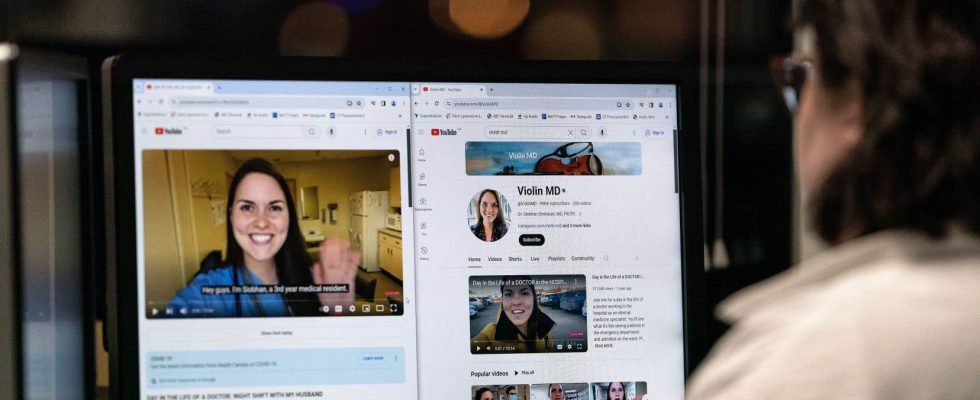When the DD Siobhan Deshauer makes online videos, her main goal is to demystify medicine. His secondary objective?
“I call it “sneaking in education,” said the doctor and YouTuber, who has nearly a million subscribers on the platform. You come for that mystery and excitement, but I’m smuggling in some topics that I think are really important and that I’m passionate about. »
Some experts say one of the best ways to combat the growing tide of medical misinformation on social media is to drown it with compelling content backed by science, and Mme Deshauer, an Ontario-based specialist in internal medicine and rheumatology, is part of a growing cohort of doctors and researchers taking this approach.
Take for example one of his medical mystery videos. Mme Deshauer tells the story of a woman who suffered lead poisoning. Doctors took time to understand the cause of her symptoms, but eventually realized they were due to lead in the Ayurvedic supplements she was taking.
It’s a compelling video with an eye-catching title: “THIS SUPPLEMENT’S Deadly Disease: Medical Mystery.” The video thumbnail image shows Mme Deshauer looks shocked in front of a bright blue background. Behind her, big block letters spell out “POISONED” and an arrow points to an X-ray image of someone’s lower leg.
These are the things that hook the listener, but for Mme Deshauer, much of the video’s value comes from this “smuggled in” education.
“I covered the concept of how supplements are regulated and what one should look for when purchasing a supplement. How to ensure your safety? It wasn’t the subject, it wasn’t the title of the video, but someone would walk away knowing these things,” she explained.
Mme Deshauer, whose online username is ViolinMD in a nod to her career as a violinist before medical school, said she started making videos when she was in school to document everything that she was learning.
“And with the building of the community [d’auditeurs], I was able to hear their comments, their concerns, what they had seen in health care, maybe some of their fears, she said. And I felt like a lot of fears about health care came from not being able to access it or see what’s going on behind closed doors. »
The same tactics as for disinformation
Algorithms that deliver engaging content to users may reinforce these fears, experts say. They tend to reinforce misinformation and sensational generalizations, turning social media sites into an echo chamber harmful to some users, said Timothy Caulfield, a professor of health policy and law at the University of Alberta , who in recent years has become one of Canada’s strongest voices on the issue.
“It will be a never-ending battle,” he said. There will never be a single, simple tool to solve this incredibly complex cultural, social, economic, and technological challenge — but we are receiving more and more quality research that tells us what kinds of approaches work best. »
Mr. Caulfield argues that the most effective science communicators use some of the same tactics as those who spread misinformation – but back them up with hard data rather than pseudoscience.
There are a number of people who do this well, he said. The DD Jen Gunter, a gynecologist, has been at it for some time, tackling misinformation posted by Gwyneth Paltrow’s wellness website Goop. The Dr Samir Gupta is on Instagram and TikTok debunking wellness fads and misinformation.
Mr Caulfield believes some doctors don’t think too much about how they present their content, but those who gain an audience are very aware of it.
“You have to think about what its content will look like,” he said. Often the clinical community and the scientific community do not do this, but people who promote misinformation do. »
One such technique, he said, is to use infographics and visuals that are easily shared.
Mr. Caulfield is on the executive advisory board of LaSciencedAbord, an initiative that aims to demystify health misinformation. Members encourage independent experts to create scientific content and the organization produces it too.
“Transparency breeds trust”
Jonathan Jarry, a science communicator at McGill University’s Office of Science and Society, said another tactic is to use anecdotes.
“One can share one’s personal experiences if one can, because stories resonate more than charts and graphs,” he said, addressing scientists and doctors.
But these personal experiences must be supported by a body of evidence, he added.
It’s also better to show people the evidence, rather than just telling them how they should feel, Jarry said.
“People don’t want to be told what to think. They don’t want us to be paternalistic. They want to be shown the work. We must show them our research, show them how we arrived at our conclusions, he argued. Transparency breeds trust. »
The DD Kathleen Ross, president of the Canadian Medical Association, said her organization has conducted surveys showing doctors are a reliable source of health information.
“Unfortunately, right now in Canada, many Canadians — almost seven million — do not have access to this source of primary care to speak with. Misinformation and the assimilation of misinformation is therefore a huge risk and leads to bad outcomes,” she said.
“To solve this problem, we must turn to reliable sources. »
